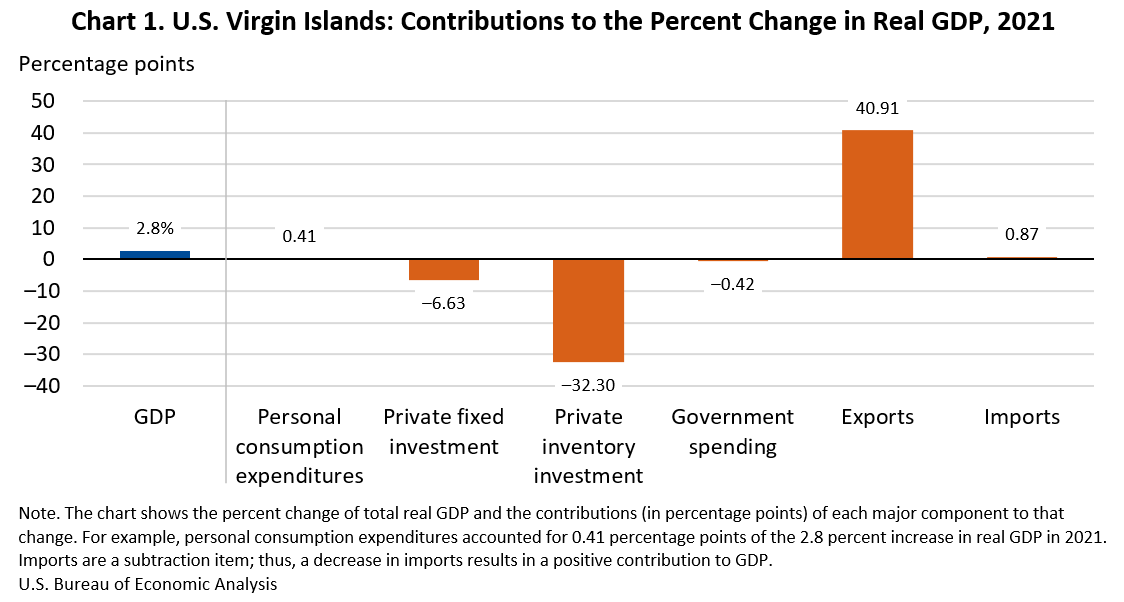News Release
Gross Domestic Product for the U.S. Virgin Islands, 2021
Gross Domestic Product by Industry and Compensation by Industry, 2020
Real gross domestic product (GDP) for the U.S. Virgin Islands (USVI) increased 2.8 percent in 2021 after decreasing 1.9 percent in 2020 (table 1.3), according to statistics released today by the U.S. Bureau of Economic Analysis (BEA). These statistics were developed under the Statistical Improvement Program funded by the Office of Insular Affairs (OIA) of the U.S. Department of the Interior.
GDP for 2021
The increase in real GDP reflected increases in exports and personal consumption expenditures (chart 1). These increases were partly offset by decreases in private inventory investment, private fixed investment, and government spending. Imports, a subtraction item in the calculation of GDP, also decreased.
In 2021, the USVI economy was affected by the continued federal government response related to the COVID–19 pandemic. Territorial government and consumer spending were supported by federal payments authorized by the Coronavirus Aid, Relief, and Economic Security (CARES) Act of 2020; the Coronavirus Response and Relief Supplemental Appropriations (CRRSA) Act of 2021; and the American Rescue Plan Act of 2021. Expenditures funded by these payments are reflected in the GDP estimates. However, the full effects of the pandemic cannot be quantified in BEA statistics for the USVI, because the impacts are generally embedded in the data sources used to estimate the components of GDP.
Exports increased 94.9 percent (table 1.3), reflecting increases in both goods and services. The growth in exports of goods primarily reflected increases in exports of crude oil and petroleum products. Exports of services, which consists primarily of spending by visitors, also increased. Total visitor arrivals were higher in 2021 than in 2020. Although cruise arrivals were lower, statistics published by the USVI government show that arrivals of air visitors, who spend more on the islands than cruise visitors, were 97 percent higher in 2021.
Personal consumption expenditures increased 0.6 percent (table 1.3), reflecting increases in spending on both goods and services. Consumer spending was supported by government assistance payments distributed to households through the CRRSA Act and the American Rescue Plan Act.
Private inventory investment decreased (table 1.2), as crude oil and petroleum product inventories were drawn down for export and use in petroleum refining.
Private fixed investment decreased 36.8 percent (table 1.3), reflecting declines in business spending on construction and equipment. Investment spending had been elevated in prior years to support capital improvement projects, including the restart of the oil refinery on St. Croix.
Government spending decreased 1.2 percent (table 1.3), primarily reflecting a decline in spending by the federal government. Federal government spending decreased after being elevated in 2020 to support reconstruction of federal facilities heavily damaged during the 2017 hurricanes Irma and Maria. Territorial government spending decreased 0.3 percent (table 1.3), reflecting a decline in compensation of employees.
GDP by industry and compensation by industry for 2020
In 2020, real GDP decreased 1.9 percent. The newly available GDP by industry data, which are released one year after the preliminary GDP statistics, reveal that the private sector was the source of decline in real GDP in 2020 (table 2.5).
The decline in the private sector was widespread. Goods-producing industries decreased 15.3 percent (table 2.4), reflecting a decline in construction activity. The largest source of decline within services-producing industries was accommodation and food services, which decreased 27.7 percent, reflecting a decrease in visitor spending. These declines were partly offset by a 4.8 percent increase in other services, except government, which includes transportation and warehousing of crude oil and petroleum products.
The government sector increased 11.0 percent (table 2.4), reflecting growth in compensation for both territorial and federal government employees.
Total compensation decreased from $2,592 million in 2019 to $2,546 million in 2020 (table 2.6). The $46 million decrease reflected widespread declines in the private sector.
Estimates for 2018–2020 that were released on March 4, 2022, have been revised to incorporate updates to source data, including the following:
- Newly available data sources provided by the USVI government, such as draft and audited financial statements for the Government of the USVI and its independent agencies and consumer price indexes for 2020, and
- Revised data on shipments from the U.S. Census Bureau "International Trade in Goods and Services" (FT900) report.
The revised estimates exhibit a pattern of inflation-adjusted GDP growth similar to the previously published estimates (table 1.7).
Due to lags in the availability of data for various components of GDP, the statistics presented today for 2021 are preliminary estimates. As of April 2023, most of the USVI government's fiscal year 2021 audited financial statements were unavailable. In place of these financial statements, BEA used information from a variety of alternate data sources, including USVI government budget documents, unaudited financial statements, building permit values, reports on federal grant expenditures and disaster recovery progress, testimonies from the Legislature of the USVI’s committee meetings, hospital cost reports from the Centers for Medicare & Medicaid Services, and the USVI government's Open Finance database, which includes checkbook-level spending by the primary government. As additional source data become available, BEA will incorporate the information and will release updated estimates once a year.
For more information on the data sources underlying these estimates, see Summary of Methodologies: Gross Domestic Product for American Samoa, the Commonwealth of the Northern Mariana Islands, Guam, and the U.S. Virgin Islands.
Next release: First Quarter 2024
Gross Domestic Product for the U.S. Virgin Islands, 2022
Gross Domestic Product by Industry and Compensation by Industry, 2021
